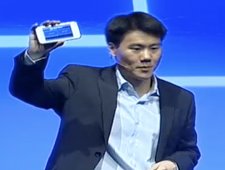Mobile device runs Windows and Android simultaneously
Feb 25, 2009 — by LinuxDevices Staff — from the LinuxDevices Archive — views VMware has demonstrated Windows CE and Google's Linux-based Android stack running side by side on a single mobile device (left). The underlying “Mobile Virtualization Platform (MVP)” technology, which includes a “hypervisor” only about 20KB in size, is being evaluated by handset manufacturers, says the company.
VMware has demonstrated Windows CE and Google's Linux-based Android stack running side by side on a single mobile device (left). The underlying “Mobile Virtualization Platform (MVP)” technology, which includes a “hypervisor” only about 20KB in size, is being evaluated by handset manufacturers, says the company.
(Click here for a larger view of VMware's Mobile Virtualization Platform)
The demonstration of MVP took place earlier this morning at VMWare's VMworld Europe 2009 technology conference, at the end of a keynote delivered by Stephen Herrod, the company's CTO. The technology will allow customers to run two operating systems on one phone simultaneously, or simply move their phone's contacts, apps, and other data from handset to handset more easily, Herrod told his audience.
MVP, touted as “very thin and very thrifty,” is a hypervisor that loads on a phone's “bare metal” hardware in advance of any operating system, and takes up only about 20KB of memory, according to VMWare. The technology, which allows a phone to load single or multiple OSes in virtual machines (VMs), stems from VMWare's 2008 acquisition of Trango, which first shipped its Trango Hypervisor in 2005.
Explaining VMWare's expansion into the world of mobile devices, Herrod said, “The mobile phone is becoming the mobile personal computer. Those of us who've been involved in the personal computer world can look at our friends in the mobile space and warn them — a lot of the challenges we've seen in the PC space are coming to phones.”
According to Herrod, MVP will benefit end users, who can install a single phone VM on multiple devices, backing up data and maintaining a familiar working environment as they migrate. Or, he added, users can have multiple VMs on a single device, each embodying a different “persona.”
For example, a “completely isolated” work VM would contain the operating system chosen by an enterprise, with confidential emails, applications, and VPN software. Meanwhile, a separate VM would contain a user's personal emails, photos, and music files. “People don't want to have to carry two phones — the one that's approved by IT, and the cool one that has a little more personality to it,” Herrod quipped.
Meanwhile, Herrod said, MVP will also benefit carriers, who will no longer need to test their custom software stacks to ensure they'll work on multiple phones. And, he added, application developers will be able to distribute their products to phones as “virtual appliances.”


VMWare's Stephen Herrod (left) and Jerry Chen (right)
Herrod was joined on stage by Jerry Chen (above), VMWare's senior director of enterprise desktop platforms, who demonstrated MVP on a Nokia N800 tablet. The N800, said to have been equipped with 128MB of RAM and 256MB of flash storage, was shown running Windows CE 6.0 and Google's Android simultaneously, each in its own VM.
According to Chen, each VM occupies only about 40MB of storage, and both run simultaneously. In his demonstration, Windows CE was used to play solitaire, while Android was used to find out the local time at VMWare's base in Palo Alto, Calif.
A demonstration of the Nokia N800 running Windows CE and Android via MVP
Source: ITPro
(click to play)
Further information
The embedded video above shows a interesting demonstration of MVP staged on the VMworld Europe 2009 show floor. For further information, see the ITPro website, here, and VNUnet.com, here.
To see the complete keynote referenced earlier in this story, see the VMware website, here. (Jerry Chen's demonstration of MVP takes place at approximately 65:28.)
According to VMWare, MVP is now being evaluated by handset manufacturers, but no timetable for its public availability was provided. For background information on the technology, which runs on ARM processors, see the company's website, here.
This article was originally published on LinuxDevices.com and has been donated to the open source community by QuinStreet Inc. Please visit LinuxToday.com for up-to-date news and articles about Linux and open source.